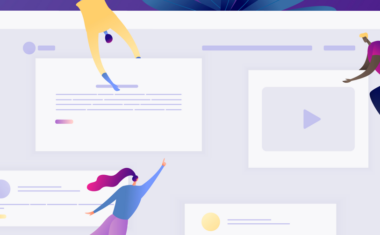Free UX Design Course
Dive into UX design with our free starter course. Transform your creative ideas into user-friendly solutions.
User experience designers were among the most in-demand professionals in 2020, according to a LinkedIn report, and the profession remains on the rise in 2021 as organizations continue their hiring sprees to support their digital transformations. But while the demand is high, the competition has also gotten tough—newcomers to UX design have to compete with thousands of recent graduates of design degrees and bootcamps to land coveted roles, and it can be especially hard for those who are just starting out to get noticed when they lack industry experience.
Fortunately, there are ways to get around that, according to Springboard mentor Jamal Nichols. Nichols is the founder of Truth About Design, a platform where he offers guidance to those looking to break into the design industry. Prior to that, he was a designer at Google, Facebook, Walmart, and BMW. In the following Q&A with Springboard, Nichols shares tips on how new graduates and those with little to no experience can start a career in UX design.
Related Read: What is UX design? and What Does a UX Designer Do?
Can you introduce yourself and tell us a bit about your background?
I’m a military brat. I was born in Germany, raised in Germany, went to school there, [went] to college there. And about six years ago, I decided to move to the Bay Area because as far as the design and the tech in the UX field, there’s just way more interesting stuff happening in the Bay Area, and I just want to just test my limits. So that’s how I arrived here.
Why UX design?
I kind of got lucky. At the time, there were no UX design degrees, so I studied media systems design when I was in Germany, which was sort of interdisciplinary and a mix of design and computer science and economics. It’s the perfect thing to study for people who can’t really decide what they want to do with their lives. But I very quickly figured out that I was just good at the design part. And then I just started growing that. And as I discovered that the user experience field was growing and that type of design was growing and that I had a knack for it, I just stuck with it.
Get To Know Other Design Students
Erich Schulz
Product Designer at Disney Parks, Experiences And Products
Bre Walker
UX Designer at KeyBank
Ethan Miller
Product Designer at Intuit
You’ve worked in a number of industries ranging from auto to finance and tech. How does UX design differ in terms of approach based on industry or product?
The process of designing things, doing research, understanding who you’re designing for, and prototyping and coming up with the final product is very similar across industries. And that’s why I was able to work in so many different industries. The thing that differs is how the industries think about design, not how the designers practice design. For example, when you’re in banking, people tend to be more conservative. They don’t want to take as many risks and that can be tough for designers because you can’t really unleash your creative ideas the way you want to.
On the other hand, when I was in the gaming industry, you could just go wild and do whatever you wanted because you were working with people in their late teens and early 20s who understood technology. And that sort of middle ground was, when I was in retail, working at Walmart, because they just cover such a broad spectrum of people and various different segments. It was an interesting mix where you got to push the boundaries sometimes. In general, the way you practice design is going to be the same across industries, and that’s why it’s relatively easy to make the switch across industries.
Let’s talk about getting into the UX design industry. You’ve worked at companies like Google and Facebook—what are they looking for in UX design hires? And how does a newcomer with little industry experience stand a chance when applying to those kinds of companies?
A lot of times when I ask students where they would like to work, they’ll always say, “Oh, I want to work at Facebook,” “Oh, I want to work at Apple,” but they never think about, “Okay, what do you even have to offer? Why would they hire you? Because they’ve never been in a position where they had to hire someone else. Think about it: if you’re hiring someone else, you want to find someone that fits the team that you enjoy being around that can do the job. And oftentimes, when you’re just starting out, I mean, you just have so much more to learn, right? So, in order to get into one of those big tech companies, my recommendation is to consistently do your best work for a long time and keep learning and keep growing in your craft, and continue to build the craft and learn everything you can. For the first three years after college, I spent almost all of my free time just reading everything I could, every blog post on every site, every book that was out there, I read them all. And only after doing that for another three years after college, I started getting the feeling that I’m kind of decent at this, and that’s when the bigger companies started taking notice, too.
Building on that, if someone is still a student, how can they set themselves up for success when they graduate?
What’s really, really important there is that you have that tenacity that we talked about earlier, that you don’t give up, that you’re willing to work hard on your own and not just [rely on someone else to do it for you]. I’m a mentor. I’m not your personal trainer, right? A personal trainer will tell you exactly what to do all the time, while a mentor takes someone who is already driven and already kind of knows what they want and gives them a few pointers to accelerate their trajectory. The person is already going and the mentor is like, “Okay, just adjust yourself a little bit and you’ll go even better and even faster.” So, being tenacious, being hardworking, being a good communicator, knowing how to ask for help—I think that’s really, really important.
You’ve also talked about the importance of being open to projects and taking whatever comes your way, especially when you’re just starting out.
The fact is when you’re getting into the industry and you don’t have much to offer, those first projects, you better take whatever you can get, and you better be happy about it, that you’re getting anything at all, because there are people that aren’t getting things.
Final question: What are some of the most important tools that anyone looking to get into UX design should know how to use?
So, when it comes to the UX field, there are a lot of tools out there, but the ones that I highly recommend you focus on above all else—don’t even worry about the other tools right now—is Sketch, because it’s the industry standard. Sketch what you’ll use for low-fidelity wireframes and for high-fidelity visual work. Just use Sketch. Don’t worry about anything else. If you want to add animations into your work once you’ve got the high-fidelity mockups done and you want to do animations and micro-interactions, use Principle. That’s the tool that everyone’s using, and it integrates perfectly with Sketch. There are a lot of other tools out there, but these are tools that everyone’s using. And if you’re getting a job in UX, you’re going to be using what your team is using, and in most cases, that’s going to be Sketch and Principle.
See here Springboard mentor Meg Clayton’s UX design career journey.
Since you’re here…
Are you a future UX designer? Enroll in our UI/UX Bootcamp and join over 10,000 students who have successfully changed careers with us. Want to get wireframing right this second? Check out our free UX design course today.







